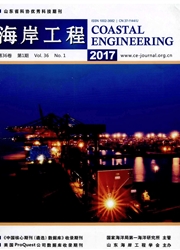

 中文摘要:
中文摘要:
借助GIS技术,对1980年—2005年间的6幅海图进行数字化,建立DEM,并以0,-2,-5,-10 m等深线进行叠加,同时选取4个典型断面,从平面上和断面上对长江口南支下段河势变化及稳定性进行分析。结果表明:1)南支下段1980年—2005年间沙洲迁移、汊道消亡、汊道再生、冲淤交替,具体表现为:分流沙洲冲刷下移,通道淤废;分流口上游沙体新的通道产生,分流口上提。2)典型断面显示出下段河槽为复式河槽,尤其是位于中部的河槽断面变化最为剧烈,其上游和下游断面河槽多年来形态相对较为稳定。3)较大幅度的冲刷和淤积大都发生在滩槽交替变化且河床坡度较陡区段。4)径流输沙、特大洪水、潮流作用与科氏力一起,是影响南支下段河势变迁的主要因素。
 英文摘要:
英文摘要:
By means of GIS,6 charts availabe in the time from 1980 to 2005 are respectively digitized to set up digital elevation model(DEM).The horizontal displacements of the 0 m,-2 m,-5 m,and-10 m isobaths can be detected if the charts is overlapped each other.Also 4 typical sections respectively across the southern channel are selected to analyze the riverbed variation and stability in the lower segment of the southern channel in the yangtze Estuary.As it is learnt from the analysis results,sandbanks are often displaced,some branches disappeas in the southern channel sometimes and reappears other times,and mud-deposition and erosion are irregularly alternated.The concret variations are that after some sandbank at waterway bifurcation has been eroded and displaced downstream,mud-deposition takes place in the waterway and the waterway becom abandoned,and after a new waterway has been formed in the sandbank upstream from the original waterway bifucation,the corresponding bifurcation becomes upstream displaced.2)Multiple troughs can be detected in the riverbed of the lower segment,as shown in the 4 typical sections.The riverbed fluctuations become the most obvious in the 2 sections across the middle area of the lower segment.The riverbed is relatively stable in either the upstream section or the downstream section.3)heavy erosion or deposition often takes place where a sandbank and a trough are close to one another or where the riverbed becomes much sloped.4)The main causative factors effecting the riverbed variations in the lower segment of the southern channel are sand-transport by runoffs,unusally strong flood,tidal current action,and Coriolis force.
 同期刊论文项目
同期刊论文项目
 同项目期刊论文
同项目期刊论文
 期刊信息
期刊信息
